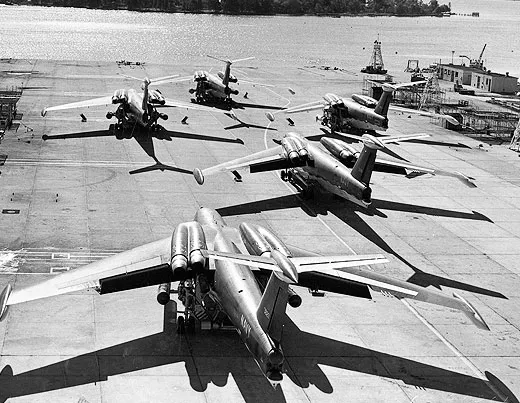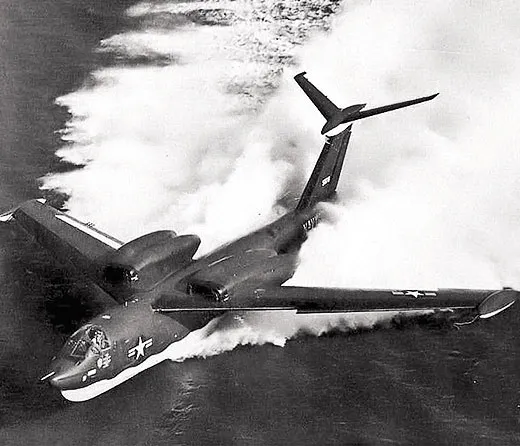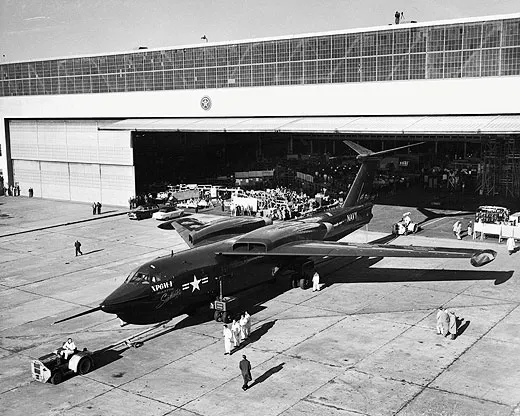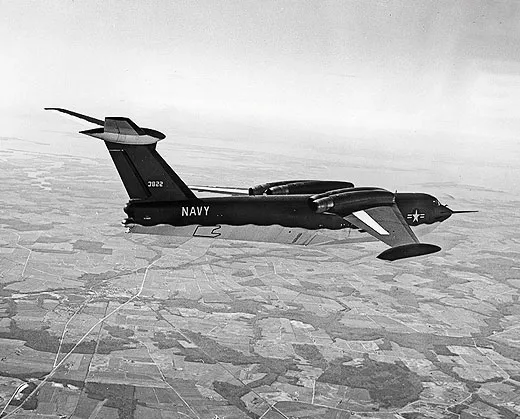Cancelled: The Navy’s SeaMaster
The Navy wanted a nuclear bomber of its own; the Glenn Martin Company thought, Why not a flying boat?
/https://tf-cmsv2-smithsonianmag-media.s3.amazonaws.com/filer/Seamonsters_of_the_Navy_03012012_3_FLASH.jpg)
In the early days of the cold war, the U.S. Navy was feeling left out. The future was nuclear, and the Air Force’s Strategic Air Command seemed to have a lock on the delivery systems. The Navy’s first bid for a piece of the strategic pie, the supercarrier USS United States, was killed by the Pentagon in favor of the Air Force’s B-36 bomber, so the admirals came up with a plan for a force of nuclear-armed seaplanes.
The Seaplane Striking Force would comprise jet-powered flying boats capable of long-range strategic nuclear attack and more mundane tasks such as conventional bombing, mine-laying, and reconnaissance. From the get-go, the Martin P6M SeaMaster (chosen over a competing design from Convair) was something of a contradiction in terms. Seaplanes need to be adept at low-altitude, low-speed flying—tasks not usually associated with high-power jet engines. The first of two prototypes, designated the XP6M-1, made its first flight on July 14, 1955. It featured four Allison J71-A-4 turbojet engines mounted in two nacelles on top of the fuselage near the wing roots,
For stability on the water, the wings, swept 40 degrees, had a distinct anhedral—they drooped, allowing the wingtip tanks to sit on the water and serve as stabilizing floats, with no struts to induce drag. Initial testing, conducted in secret on the Chesapeake Bay near Martin’s Baltimore headquarters, revealed that the jet exhausts were too close to the fuselage and scorched it when the afterburners were used.
The Navy rolled the airplane out in November 1955, inviting the press to view the second prototype. After a demo flight, Chief of Naval Operations Admiral Arleigh Burke extolled the SeaMaster’s “beautiful performance.”
A month later, a control malfunction with the horizontal stabilizer caused the first prototype to break up in flight, killing all four crew members. Test flights of the remaining airplane resumed in May 1956 after modifications to the T-tail and installation of improved flight control and test instruments, along with ejection seats. Those would come in handy six months later, when the SeaMaster lost pitch control during a test flight and began vibrating uncontrollably. The crew escaped before the airplane broke up over the bay.
Undeterred, the Navy tested the YP6M-1 pre-production model, with the nacelles angled five degrees from the fuselage, and began refitting four old ships and a submarine to serve as SeaMaster support vessels. A beaching cradle enabled the Y model to get in and out of the water under its own power. Even New York Times military editor Hanson W. Baldwin, generally jaded when it came to Pentagon hype, was impressed by the aircraft’s “flexible operational capability, with the world’s oceans and lakes as its indestructible runways.”
The full-fledged production SeaMaster, the P6M-2, debuted in early 1959. It featured more powerful Pratt & Whitney J75-P-2 turbojet engines (with no afterburners), an aerial refueling probe, a rotating watertight bomb bay, Sperry navigation, flight control and autopilot systems, a high-visibility canopy, and a probe-and-drogue kit for conversion to a tanker. The added weight of the modifications made the P6M-2 ride lower in the water, eliminating the need for the wing anhedral.
The new and improved SeaMaster could now give the Air Force a run for its money. Its top low-altitude speed, Mach 0.9, surpassed even that of the Strategic Air Command’s new B-52, which on the deck could do only slightly better than Mach 0.5. Naval aviators, readying for SeaMaster operations at a test area in North Carolina, were enthusiastic about the craft’s potential as a mine-layer: It would be able, they declared, to mine the Black Sea and attack Soviet submarines before they could leave port.
In the meantime, the advancing technology of the Fleet Ballistic Missile submarine had made the Seaplane Striking Force less critical to the Navy’s future—and there were much cheaper ways to lay mines. The program’s numerous delays and redesigns were consuming funds the Navy urgently needed elsewhere. “The Navy has reduced its once hopeful Martin SeaMaster project rather drastically,” Hanson Baldwin noted glumly. An initial production forecast for 24 SeaMasters was cut to 18, then eight. In August 1959, having spent about $400 million, the Navy finally pulled the plug.
Martin tried to modify the SeaMaster concept into an eight-engine civilian airliner called the SeaMistress, and also toyed with the notion of a nuclear-powered flying boat and a supersonic seaplane. But the SeaMaster and its derivatives were dead in the water. Martin gave up building aircraft entirely to concentrate on military electronics and missiles. The remaining SeaMasters were scrapped except for two tails, a fuselage section, and wing floats, which now reside in the Glenn L. Martin Aviation Museum in Baltimore, and four wingtip floats a Martin employee scrounged to build a catamaran.
Frequent contributor Mark Wolverton greatly prefers overflying water to swimming in it.



